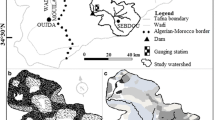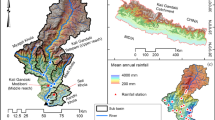Abstract
Climatic extremes including precipitation are bound to intensify in the global warming environment. The present study intends to understand the response of the Tons sub-watershed in Lesser Himalaya, in 3 years with entirely different hydrological conditions (July 2008–June 2011) in terms of discharge, sediment flux and denudation rates. Within an uncertainty limit of ±20%, the mean interannual discharge (5.74 ± 1.44 m 3 s −1) (±SE), was found highly variable (CV: 151%; 0.8–38 m 3 s −1). In a normal rainfall year (2008–2009; ∼1550 mm), the discharge was 5.12 ± 1.75 m 3 s −1, whereas in a drought year (2009–2010), it reduced by 30% with the reduction in ∼23% rainfall (CV: 85%). In an excessive rainfall year (once-in-a-century event) (2010–2011; ∼3050 mm), discharge as well as total solid load was ∼200% higher. Monsoon months (July–September) accounted for more than 90% of the annual solid load transport. The ratio of dissolved to suspended solid (C/P ratio) was consistently low (<1) during monsoon months and higher (1–7) during the rest of the dry period. C/P ratio was inversely (R 2=0.49), but significantly (P <0.001) related to the rainfall. The average mechanical erosion rate in the three different rainfall years was 0.24, 0.19 and 1.03 mmyr −1, whereas the chemical erosion was estimated at 0.12, 0.11 and 0.46 mmyr −1, respectively. Thus, the average denudation rate of the Tons sub-watershed has been estimated at 0.33 mmyr −1 (excluding extreme rainfall year: 1.5 mmyr −1). Our results have implications to understand the hydrological behaviour of the Lesser Himalayan watersheds and will be valuable for the proposed and several upcoming small hydropower plants in the region in the context of regional ecology and natural resource management.





Similar content being viewed by others
References
Ali K F and De Boer D H 2007 Factors controlling specific sediment yield in the upper Indus River basin, northern Pakistan; Hydrol. Process. 22 (16) 3102–3114.
Bajracharya R M, Sharma S and Clemente R 2004 Discharge and sediment loads of two streams in the mid-hills of central Nepal; Himalayan J. Sci. 2 (3) 51–54.
Barnard P L, Owen L A, Sharma M C and Finkel R C 2001 Natural and human induced landsliding in the Garhwal Himalaya of northern India; Geomorphology 40 21–35.
Bartarya S K 1988 Geohydrological and geomorphological studies of the Gaula river basin (district Naini Tal) with special reference to the problem of erosion; Unpublished Ph.D thesis; Kumaun University, Nainital.
Bisht S, Sharma S and Chaudhry S 2016 Flash flood risk susceptibility in Gagas River Watershed–Kumaun Lesser Himalaya; Int. J. Adv. Remote Sens. GIS 5 (5) 1709–1725.
Buchanan T J and Somers W P 1969 Discharge measurements at gaging stations: U.S Geological Survey Techniques of Water-Resources Investigations; book 3, chapter A8, 65p.
Bhutiyani M R 2000 Sediment load characteristics of a proglacial stream of Siachen Glacier and the erosion rate in Nubra valley in the Karakoram Himalayas, India; J. Hydrol. 227 (1) 84–92.
Burbank D W and Beck R A 1991 Rapid long term rates of denudation; Geology 19 1169–1172.
Caine N and Swanson F J 1989 Geomorphic coupling of hillslope and channel systems in small mountain basins; Zeitschrift für Geomorphologie 33 (2) 189–203.
Chauhan P, Chauniyal D D, Singh N and Tiwari R K 2016 Quantitative geo-morphometric and land cover based micro-watershed prioritization in the Tons River basin of the Lesser Himalaya; J. Environ. Earth Sci. 75 498 . doi:10.1007/s12665-016-5342-x.
Chaudhary R S and Sharma P D 1999 Runoff and sediment yield from Giri river catchment in Himachal Pradesh; Indian J. Soil Conserv. 27 (1) 1–9.
Choden S L. 2009 Sediment transport studies in Punatsangchu River, Bhutan; Master Project TVVR 09/5005, ISRN LUTVDG/TVVR-09/5005 ISSN-1101-9824.
Curray J R and Moore D G 1971 Growth of the Bengal deep-sea fan and denudation in the Himalayas; Geol. Soc. Am. Bull. 82 (3) 563–572.
Das K N 1968 Soil erosion and the problem of silting in the Kosi catchment; J. Soil Water Conserv. India 16 (3-4) 60–67.
Dimri A P, Thayyen R J, Kibler K, Stanton A, Jain S K, Tullos D and Singh V P 2016 A review of atmospheric and land surface processes with emphasis on flood generation in the southern Himalayan rivers; Sci. Total Environ. 556 98–115.
Fagbohun O O 2016 Studies on small hydro-power potentials of Itapaji Dam in Ekiti State, Nigeria; Int. J. Eng. Sci. Inven. 2319–6734, ISSN (Print) 2319–6726.
Fergusson R I 1984 Sediment load of Hunza river; In: International Karakoram Project 2 (ed.) Miller K J, Cambridge University Press, Cambridge, pp. 581–597.
Good S P, Noone D and Bowen G 2015 Hydrologic connectivity constrains partitioning of global terrestrial water fluxes; Science 349 (6244) 175–177.
Gregory J K and Walling D E 1973 Drainage Basin Form and Process: A Geomorphological Approach; Edward Arnold, London, 456p.
Gregory K J 1979 Drainage network power; Water Resour. Res. 15 (4) 775–777.
Grinsted A, Moore J C and Jevrejeva S 2004 Application of the cross wavelet transform and wavelet coherence to geophysical time series; Nonlin. Process. Geophys. 11 561–566.
Hosseinia S M H, Forouzbakhshb F and Rahimpoora M 2005 Determination of the optimal installation capacity of small hydro-power plants through the use of technical, economic and reliability indices; J. Energy Policy 33 1948–1956.
Jha P K, Subramanian V and Sitasawad R 1988 Chemical and sediment mass transfer in the Yamuna River – a tributary of the Ganges system; J. Hydrol. 104 (1) 237–246.
Kesharwani M K 2006 Overview of small hydro power development in the Himalayan region; Himalayan Small Hydropower Summit (October 12–13 2006); Dehradun, India.
Kumar P 1987 Geomorphological evaluation of environmental degradation and management in Dhauliganga Basin (Central Himalayas); Ph.D. thesis, Jawaharlal Nehru University, New Delhi, India.
Lehmann J, Coumou D and Frieler K 2015 Increased record-breaking precipitation events under global warming ; Climatic Change 132 (4) 501–515.
Lupker M, Blard P H, Lave J, France-Lanord C, Leanni L, Puchol N, Charreau J and Bourles D 2012 10Be-derived Himalayan denudation rates and sediment budgets in the Ganga basin; Earth Planet. Sci. Lett. 333–334 146–156.
Menard H W 1961 Some rates of regional erosion; J. Geol. 69 (2) 154–161.
Milliman J D and Meade R H 1983 World-wide delivery of river sediment to the oceans; J. Geol. 91 1–21.
Milliman J D and Syvitski J P M 1992 Geomorphic/ tectonic control of sediment discharge to the ocean: The importance of small mountainous rivers; J. Geol. 100 525–544.
Nagle G N, Fahey T J and Lassoie J P 1999 Management of sedimentation in tropical watersheds; Environ. Manag. 23 (4) 441–452.
Pradhan P M S 2004 Improving Sediment Handling in the Himalayas; Hydro Lab Pvt. Ltd. GPO Box 21093; Kathmandu, Nepal.
Prasad B and Dave A 2012 Geology of Lesser Himalaya sequences in Mussoorie Syncline around Dehradun–Mussoorie area (field excursion by Society for Petroleum Geophysicists (SPG)).
Rao S V N, Rao M V and Ramasasitri K S 1997 A study of sedimentation in Chenab Basin in western Himalayas; Nord. Hydrol. 28 201–216.
Rawat J S 2010 Database management system for Khulgad watershed, Kumaun Lesser Himalaya, Uttarakhand, India; Curr. Sci. 98 (10) 1340–1348.
Rawat P K, Tiwari P C, Pant C C, Sharma A K and Pant P D 2011 Modelling of stream run-off and sediment output for erosion hazard assessment in the Lesser Himalaya: Need for sustainable land use plan using remote sensing and GIS: A case study; Nat. Hazards 59 1277–1297.
Rawat P K, Tiwari P C, Pant C C, Sharma A K and Pant P D 2012a Geo-hydrological database modeling for integrated multiple hazards and risk assessment in Lesser Himalaya: A GIS-based case study; Nat. Hazards 62 1233–1260.
Rawat P K, Tiwari P C, Pant C C, Sharma A K and Pant P D 2012b Spatial variability assessment of river-line floods and flash floods in Himalaya: A case study using GIS; Disaster Prev. Manag. 21 (2) 135–159.
Rawat J S and Rai S P 1997 Pattern and intensity of erosion in the environmentally stressed Khulgad watershed, Kumaun Himalaya; J. Geol. Soc. India 50 (3) 331–338.
Rawat J S and Rawat M S 1994 Accelerated erosion and denudation in the Nana Kosi watershed, central Himalaya, India; Part I: Sediment Load; Mt. Res. Dev. 14 (1) 25–38.
Seshadri T N 1960 Report on Kosi River and its behaviour. Investigation and research, Dn Khosi project, Birpur, Cited in: Brunsden et al. 1981 (q.v.).
Sharma P P, Gupta S C and Rawls W J 1991 Soil detachment by single raindrops of varying knit energy; Soil Sci. Soc. Am. J. 46 117–121.
Sharma R H and Ripendra A 2013 Hydropower development in Nepal; Renew Sust. Energ. Rev. 21 684–693.
Singh S K, Rai S K and Krishnaswami S 2008 Sr and Nd isotopes in river sediments from the Ganga Basin: Sediment provenance and spatial variability in physical erosion; J. Geophys. Res. 113 F03006, doi:10.1029/2007JF000909.
Singh O, Sharma M C, Sarangi A and Singh P 2008 Spatial and temporal variability of sediment and dissolved loads from two alpine watersheds of the Lesser Himalayas; Catena 76 27–35.
Sitaula B P, Garde M, Burbank D W, Oskin M, Heimsath A and Gabet E 2007 Bed load to suspended load ratio and rapid bedrock incision from Himalayan landslide-dam lake record; Qua. Res. 68 111–120.
Srivastava M 2005 Biodiversity study in natural forests abandoned mine and ecorestored mine habitats of Mussoorie Hills; Bull. Nat. Inst. Ecol. 16 59–68.
Subramanian V 1979 Chemical and suspended sediment transport characteristics of rivers of India; J. Hydrol. 44 37–55.
Thomas F S and Christoph C R 2005 Water cycle shifts gear; Nature 434 830–833.
Torrence C and Compo G P 1998 A practical guide to wavelet analysis; Bull. Am. Meteor. Soc. 79 61–78.
Valdiya K S and Bartarya S K 1989 Mass-movements in a part of Kumaun Himalaya; Curr. Sci. 58 (9) 486–491.
Weerakoon S B and Rathnayake U S 2007 Effect of the entrance zone on the trapping efficiency of desilting tanks in run-of-river hydropower plants; International Conference on Small Hydropower – Hydro Sri Lanka, 22–24 October.
Williams J R and Berndt H D 1977 Sediment yield prediction based on watershed hydrology; Trans. Amer. Sot. Agr. Eng. 20 1100–1104.
Wolman M G 1954 A method of sampling coarse river-bed material; EOS Trans. AGU 35 (6) 951–956.
Xiaoping Y 2003 Manual of sediment management and measurement. World Meteorological Organization Operational Hydrology Report No. 47 Secretariat of World Meteorological Organization; Geneva, Switzerland.
Yadav R and Sri Ram 2014 Landslides and its remedial measures in Mussoorie hilly sections; Int. J. Sci. Res. Dev. 2 (10) 842–851.
Acknowledgements
Authors are grateful to the support and necessary facilities extended by the Director, Wadia Institute of Himalayan Geology, Dehradun to carry out this study. The authors also thank the editor and anonymous reviewers for their insightful and constructive comments that helped to improve this manuscript.
Author information
Authors and Affiliations
Corresponding author
Additional information
Corresponding editor: Rajib Maity
Rights and permissions
About this article
Cite this article
Chauhan, P., Singh, N., Chauniyal, D.D. et al. Differential behaviour of a Lesser Himalayan watershed in extreme rainfall regimes. J Earth Syst Sci 126, 22 (2017). https://doi.org/10.1007/s12040-017-0796-0
Received:
Revised:
Accepted:
Published:
DOI: https://doi.org/10.1007/s12040-017-0796-0




